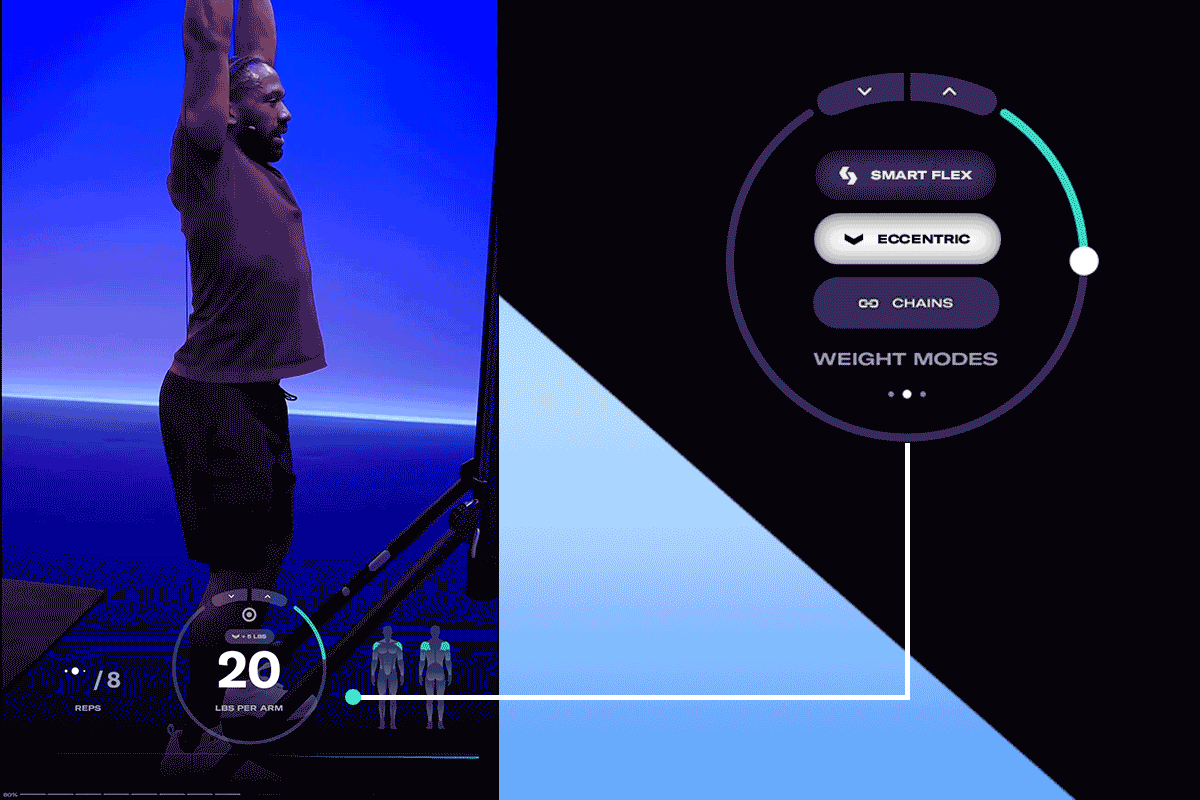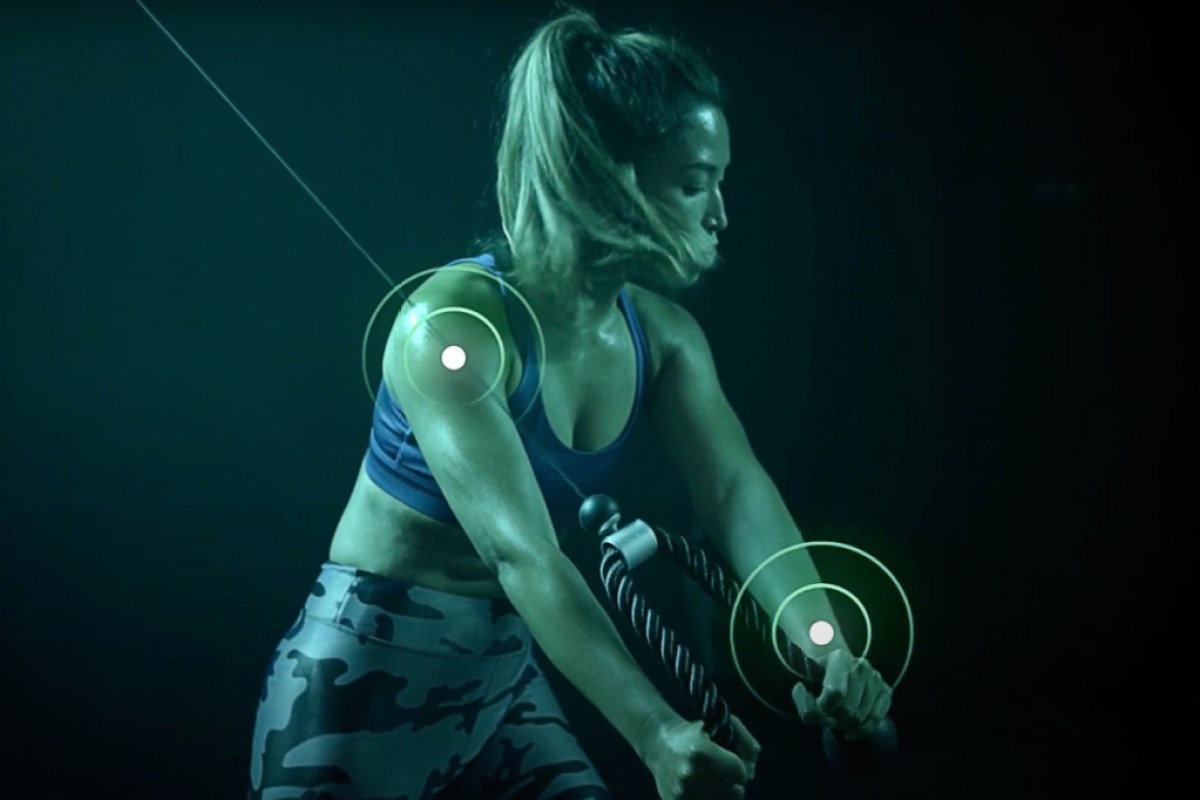Ditch the heavy lifting chains for Tonal’s intuitive dynamic weight mode, which can add more resistance to any exercise, in any direction.
Once relegated to a small niche of weight lifters with specialized equipment, lifting with chains has proven benefits but comes with a host of hassle. If you can even get past that, you’re generally limited to a single plane of motion.
That’s why Chains mode is a revolutionary technology that makes lifting with chains available to everyone, for every exercise on Tonal. With this feature, you can transform any of your sets with additional resistance at the touch of a button.
Here is everything you need to know about this dynamic weight mode and how it will help you build serious strength and power.
What Is Chains Mode?
Adding physical chains to certain lifts is a traditional method known as accommodating resistance: the weight gets heavier during the concentric (lifting) phase and lighter again in the eccentric (lowering) phase.

With Chains mode, you can leverage this same technique without a complicated set-up or clunky chains. Tonal’s digital weight seamlessly increases as you accelerate into a movement, like pushing up on a bench press, and decreases as you bring the bar back down to your chest.
An additional bonus: You know exactly how much the weight increases and can manipulate the load as well. With physical chains, it’s impossible to know exactly how much weight you’re lifting at any given moment with different chain links off the ground.
What Are the Benefits of Using Chains Mode?
Using Chains mode can help you build strength, prime you for your next rep, and present a new challenge in your workout plan. Here are four major benefits of using this feature:
Improve Max Strength
A review of the research, published in the Journal of Strength and Conditioning Research, shows using chains can improve the one-rep max for beginners and experienced athletes by up to 11 pounds in seven weeks with traditional free weights. Those free weights, though, limit you to using chains and bands on exercises that resist gravity, such as squats or deadlifts. On Tonal, you can increase the resistance on the concentric portion even during rotational moves like chops and rows.
Prepare for Heavier Lifts
Your nervous system reacts to the stress you place upon it, which means when more stress is added by chains, the better your system may react for the next rep or set. This priming of the nervous system for future work is called the post-activation potentiation (PAP), explains Jay Dawes, PhD, Associate Professor in Kinesiology at Oklahoma State University.

When you overload a movement on the concentric phase, say squats for example, and then immediately follow it up with a plyometric exercise like bodyweight jump squats, the PAP theory suggests that you’ll generate more power and height on the the jump squats due to the temporary neurological excitement caused by the heavier, loaded movement.
While existing research shows a wide time window when the potentiation effect can kick in, Dawes explains that you’ll be more prepared and powerful in similar movements following your workout whether it’s 30 seconds or 30 minutes after reps with Chains mode activated.
Avoid Overtraining
Your muscles and connective tissue take on heavy wear and tear during resistance training, particularly if you are including heavy or advanced lifting techniques like eccentric training. Switching it up to progressively overload the concentric portion with Chains mode and reversing the weight on the eccentric can actually be less taxing to the muscle. That means incorporating chains can create an opportunity to allow muscles to recover without resting, which is important for any athlete.
Train More Planes of Motion and Muscles
While physical chains are limited by gravity, “on Tonal, we can use chains in any plane of motion and on any exercise,” says Max Artsis, Head of Sport Performance Strategy & Athlete Experience at Tonal. “We can create the sensation of accommodating resistance on horizontal movements, rotational ones, and on exercises that we never had the capacity to before, and it’s accessible to anyone.”
Adding chains also forces the core to work harder during the concentric movement. “A lot of times, if an athlete relaxes too much on the explosive portion of a movement, I will add chains as an external cue to get them to draw from their abs, obliques, and deep core musculature.” With the dynamic nature of Chains mode, your core activates to stabilize the body while the weight changes.

How is Chains Mode Programmed For You?
Tonal’s expert programming team integrates Chains mode into workouts seamlessly to provide an added strength stimulus and progress your workouts especially when the goal is to maximize speed for large, multi-joint movements such as squats and deadlifts, explains Josh Clay, a certified strength and conditioning specialist and Fitness Programming Specialist at Tonal.
Another likely place you’ll find Chains mode is when a movement is targeting a specific muscle group in the shortened position. “In a Barbell Glute Bridge, where the most challenging portion of the movement is at the top where the glutes are shortened, Chains mode allows you to accelerate through the entire range of motion without pausing near the top to find the energy to squeeze out the last inch of the rep,” explains Clay.

Like what you’re reading? Get more stories in the Tonal app.
How Do You Activate Chains Mode On Tonal?
You can add Chains mode to any exercise on Tonal by swiping left on the digital weight dial. Select the option from the list of dynamic weight modes, and it will kick in on the second or third rep of your set. The first couple reps sense your range of motion and strength curve, then Tonal adjusts the weight based on this data.
While you can toggle Chains mode on at any time on your own, it is already built into many of the programs on Tonal such as Divide and Conquer or Unleash the Beast so the work is intuitively done for you. All you have to do is show up.



